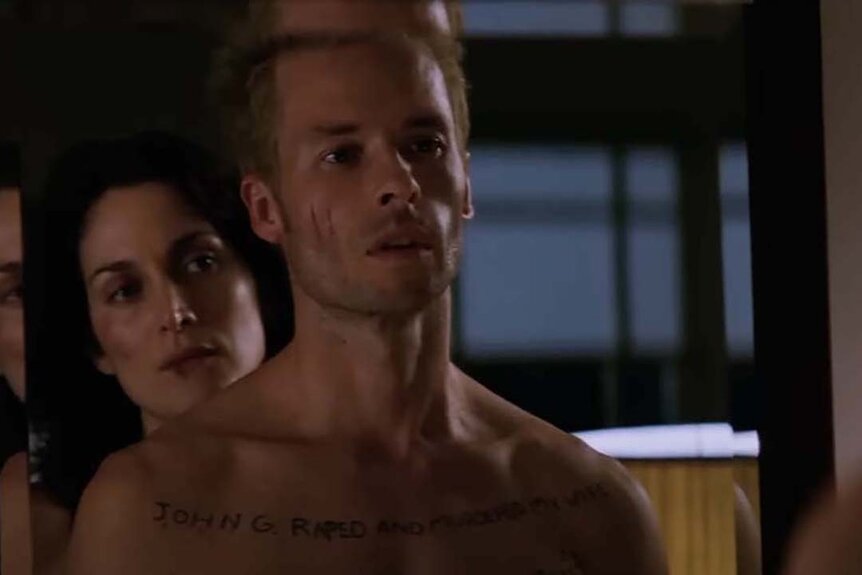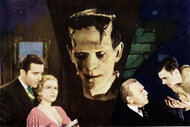Create a free profile to get unlimited access to exclusive videos, sweepstakes, and more!
The Ending of Christopher Nolan's Memento Explained
Let's take a closer look at the end of Christopher Nolan's breakthrough film.

Almost 25 years ago, Oppenheimer director Christopher Nolan broke through as a major genre force thanks to Memento, a twist neo-noir thriller that set the stage for one of modern cinema's most exciting careers, and delivered a story that we're still talking about more than two decades after its release.
Memento is still a favorite among thriller fans for its tight plotting, great characters, and thrilling revelations, but it's perhaps best remembered for its nonlinear narrative, presented in the form of two different chronologies that move in the opposite direction until they converge. That convergence, in the film's ending, gives us a resolution, to be sure, but it also leaves certain key questions unanswered. So, let's take a closer look at how Memento wraps up, and what it offers to us as viewers. If you want to follow along, the film is streaming on Peacock right now, so go watch for yourself.
The Ending of Memento Explained
As we've already established, Memento unfolds in two different ways, giving us a series of black-and-white scenes that movie in chronological order, as well as color scenes that move in reverse chronological order, until they all meet in the middle. The protagonist of the film is Leonard (Guy Pearce), a man with anterograde amnesia, which means that he can't form new memories and therefore must keep track of his life through a series of notes, pictures, and most importantly, tattoos of important clues and events. Leonard got his amnesia through a head injury sustained when his wife (Jorja Fox) was attacked and murdered in their home one day. One of the men responsible for the attack is already dead, but the other is at large, and Leonard has been using his tattoo system to hunt for that man ever since, seeking revenge for his late wife.
RELATED: Christopher Nolan Movies, Ranked
The chronological black-and-white sequences reveal all of this, and point the way to a cop named Teddy (Joe Pantoliano), who has information that will lead Leonard to his wife's killer. Meanwhile, the reverse-chronological color sequences feature a bartender named Natalie (Carrie-Anne Moss), who points Leonard in the direction of Teddy himself as his wife's killer. All the while Leonard is looking for someone named "John G" or "James G," one of his few clues as to the killer's identity, and both Teddy himself and the man Teddy sends Leonard to kill, Jimmy, match those initials in some way.
In the color sequences, Leonard finally syncs up his clues with Teddy's information (with Natalie's help) and kills him. In the black-and-white sequences, Leonard follows Teddy's clues and kills Jimmy (Larry Holden), but as Jimmy's dying, he offers Leonard a piece of information that suggests he's the wrong man (more on that in a second). Leonard confronts Teddy about this, and Teddy –– realizing that in a matter of minutes Leonard will forget the information anyway –– reveals that the real killer of Leonard's wife is already dead. In fact, Leonard killed that man a year ago, and Teddy has been using Leonard's condition to his advantage ever since, essentially making the very driven man his own personal contract killer, engineering clues that will lead Leonard to his chosen target. In response, Leonard leaves a note to himself that Teddy is not to be trusted, setting up his eventual plan to kill Teddy after Natalie provides him the clues that point in that direction. As the film ends, Leonard vows to continue his quest for revenge, and even reveals that he's willing to lead false clues to guide him if it means he can get revenge.
Memento And Unreliable Memory
So we've established what happened as the film presented it to us. Now it's time to talk a little bit about why it all happened the way it did. To do that, we need to go back to the information that Jimmy whispered to Leonard as he died. It was a single word, "Sammy," which reminded Leonard of his days as an insurance adjuster before the attack that killed his wife. In the past, Leonard met with a man named Sammy (Stephen Toblowsky), who claimed to suffer from anterograde amnesia. It was up to Leonard to determine Sammy's true status for insurance purposes, but Leonard didn't necessarily believe in Sammy's condition. It fell to Sammy's wife (Harriet Sansom Harris) to essentially test her husband by repeatedly reminding him to give her insulin shots. The idea was, of course, that if Sammy didn't have anterograde amensia, he would remember that he'd already given her the shot. Instead, he kept forgetting, and ended up overdosing and killing her.
Sammy's story looms large in Leonard's memory, at first as the origin of a certain degree of guilt, a reminder that his condition is not just real, but something of which he must constantly be mindful, lest he hurt someone who doesn't deserve it. Of course, in the end, Leonard learns through Teddy's monologue that he's been harming people who may or may not be deserving for quite some time, due to Teddy's manipulations. But that's not the end of the revelations.
While talking to Teddy, Leonard also learns that the story of Sammy and his wife is apparently not actually true, that the Sammy story is actually a story from Leonard's own life. Leonard, of course, denies this, believing that all of his memories from before his wife's death are intact, and therefore he would know whether or not his wife was a diabetic. Since we're told that his amnesia shouldn't affect his memories from before the attack, it seems we should believe Leonard.
But should we? Nolan shows us several glimpses of Leonard's life that mirror Sammy's, suggesting that perhaps Sammy is more of an invention to reckon with his own trauma, or at least a partial invention, than an actual person. If that's true, it's also possible that Leonard's wife didn't die in an attack, but in an accident brought on by Leonard.
RELATED: Christopher Nolan Explains How Atomic Blast in Oppenheimer Differs from The One in Dark Knight Rises
Or did that happen at all? Was it deliberate on Leonard's part? Did it even happen that way? Is Natalie the real puppet master in this deadly game? We don't really know, but what's important about all of this is the choice Leonard makes at the end of the film. After killing Jimmy, he resolves to go after Teddy, and makes a note to himself that will make Teddy his next target by default, effectively sealing the other man's fate. As he drives away, he contemplates his own personal view of reality, and examines the possibility that his reality may in fact be a construction. He meditates on this, closing his eyes briefly to test whether or not the objective world still exists if he doesn't observe it. In the end, it's a thought that's wiped away the moment he sees a tattoo shop, and therefore a chance to remember his latest clue in his neverending quest for vengeance.
And in the end, that's the real crux of Memento. We watch a man who's caught in a loop of violence and searching and wonder what the root cause of it all really is, whether Leonard was driven to this life or whether he chose and simply can't remember when he made that choice. It's a dramatic idea that forces us to reckon with our chances, no matter how passive they might be, and that's why the film sits in our head for hours after it ends.
Memento is now streaming on Peacock.



























